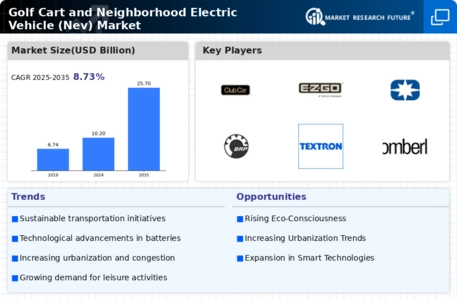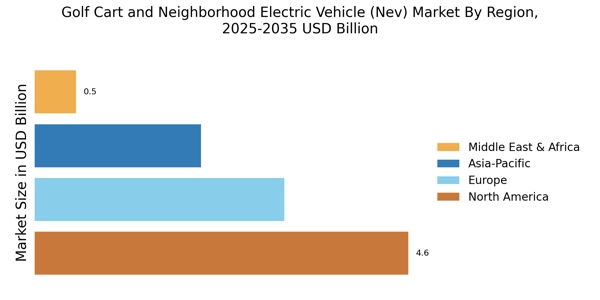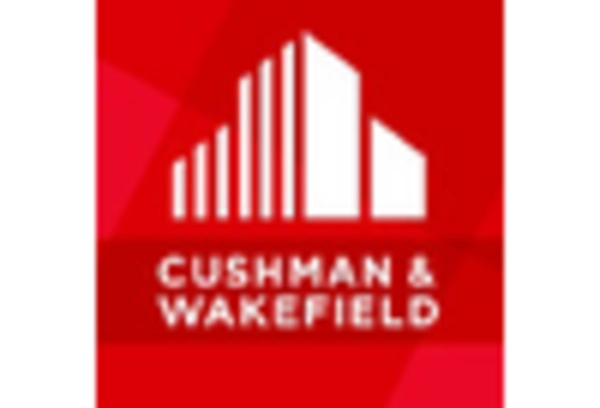Aging Population
The aging population is emerging as a notable driver for the Golf Cart and Neighborhood Electric Vehicle Market (Nev) Market. As the demographic landscape shifts, there is a growing need for accessible and user-friendly transportation solutions. Golf carts and NEVs are particularly appealing to older adults, who may require easier mobility options for short distances. The market is witnessing an increase in demand for vehicles that offer comfort, safety, and ease of use, catering specifically to this demographic. Data indicates that the population aged 65 and older is expected to grow significantly, which may lead to a corresponding rise in the demand for NEVs and golf carts. This demographic shift could potentially reshape the Golf Cart and Neighborhood Electric Vehicle Market (Nev) Market, as manufacturers adapt their offerings to meet the needs of an aging population.
Regulatory Support
Regulatory support is playing a crucial role in shaping the Golf Cart and Neighborhood Electric Vehicle Market (Nev) Market. Governments are increasingly implementing policies that promote the use of electric vehicles, including NEVs, as part of broader environmental initiatives. Incentives such as tax credits, rebates, and grants are being offered to consumers and manufacturers, which may stimulate market growth. Additionally, regulations aimed at reducing emissions are encouraging the adoption of electric vehicles, further enhancing the appeal of golf carts and NEVs. Market data suggests that regions with supportive regulatory frameworks are experiencing faster growth in the electric vehicle sector. This supportive environment is likely to foster innovation and investment in the Golf Cart and Neighborhood Electric Vehicle Market (Nev) Market, paving the way for a more sustainable transportation future.
Urbanization Trends
Urbanization trends are significantly influencing the Golf Cart and Neighborhood Electric Vehicle Market (Nev) Market. As urban areas expand, the need for efficient and compact transportation solutions becomes more pronounced. NEVs and golf carts offer a practical alternative to traditional vehicles, particularly in densely populated regions where traffic congestion is prevalent. The convenience of using smaller, electric vehicles for short commutes aligns well with the lifestyle of urban dwellers. Market analysis suggests that urban areas are increasingly adopting policies that favor the use of electric vehicles, including NEVs, to alleviate congestion and reduce pollution. This trend is likely to propel the Golf Cart and Neighborhood Electric Vehicle Market (Nev) Market forward, as more consumers seek out sustainable and efficient transportation options in urban settings.
Sustainability Initiatives
The increasing emphasis on sustainability appears to be a pivotal driver for the Golf Cart and Neighborhood Electric Vehicle Market (Nev) Market. As environmental concerns gain traction, consumers and manufacturers alike are gravitating towards eco-friendly transportation options. The market for electric vehicles, including NEVs, is projected to grow significantly, with estimates suggesting a compound annual growth rate of over 20% in the coming years. This shift is not merely a trend; it reflects a broader societal movement towards reducing carbon footprints. Consequently, golf carts and NEVs, which typically produce lower emissions compared to traditional vehicles, are becoming more appealing. Municipalities are also adopting policies that encourage the use of electric vehicles, further bolstering the market. This alignment with sustainability goals may enhance the attractiveness of the Golf Cart and Neighborhood Electric Vehicle Market (Nev) Market.
Technological Advancements
Technological advancements are reshaping the Golf Cart and Neighborhood Electric Vehicle Market (Nev) Market in profound ways. Innovations in battery technology, such as lithium-ion batteries, are enhancing the performance and efficiency of electric vehicles. These advancements not only extend the range of NEVs but also reduce charging times, making them more convenient for users. Furthermore, the integration of smart technologies, including GPS and connectivity features, is becoming increasingly common. These features provide users with enhanced navigation and safety options, which may drive consumer interest. Market data indicates that the adoption of smart technologies in electric vehicles is expected to rise, potentially increasing the market share of NEVs. As technology continues to evolve, it is likely that the Golf Cart and Neighborhood Electric Vehicle Market (Nev) Market will experience sustained growth, driven by consumer demand for innovative solutions.


















Leave a Comment